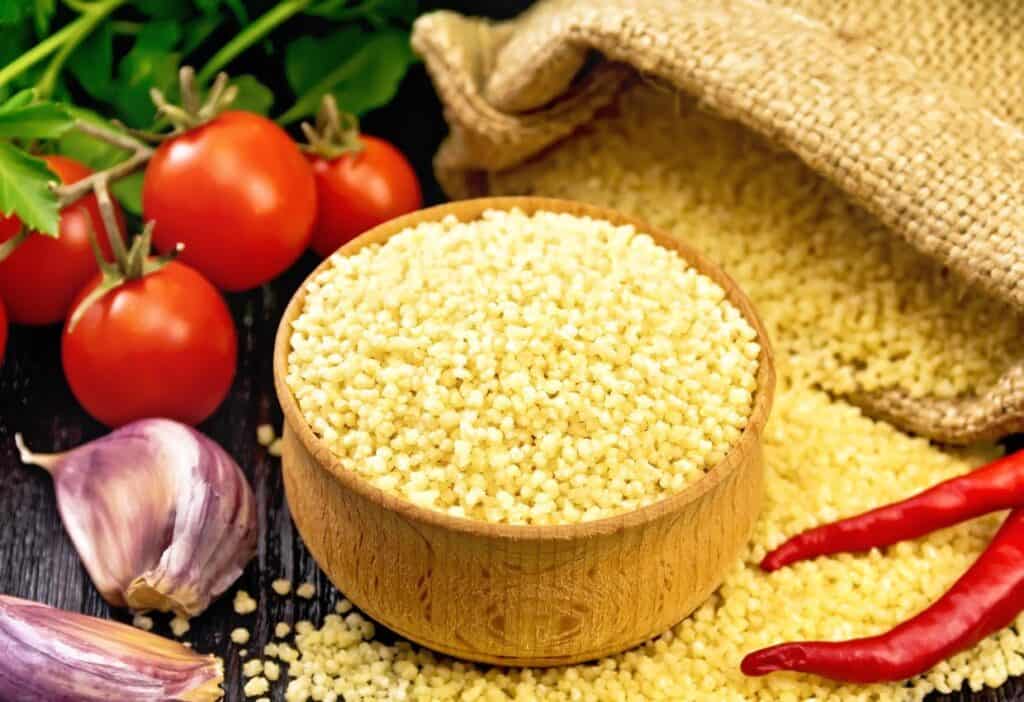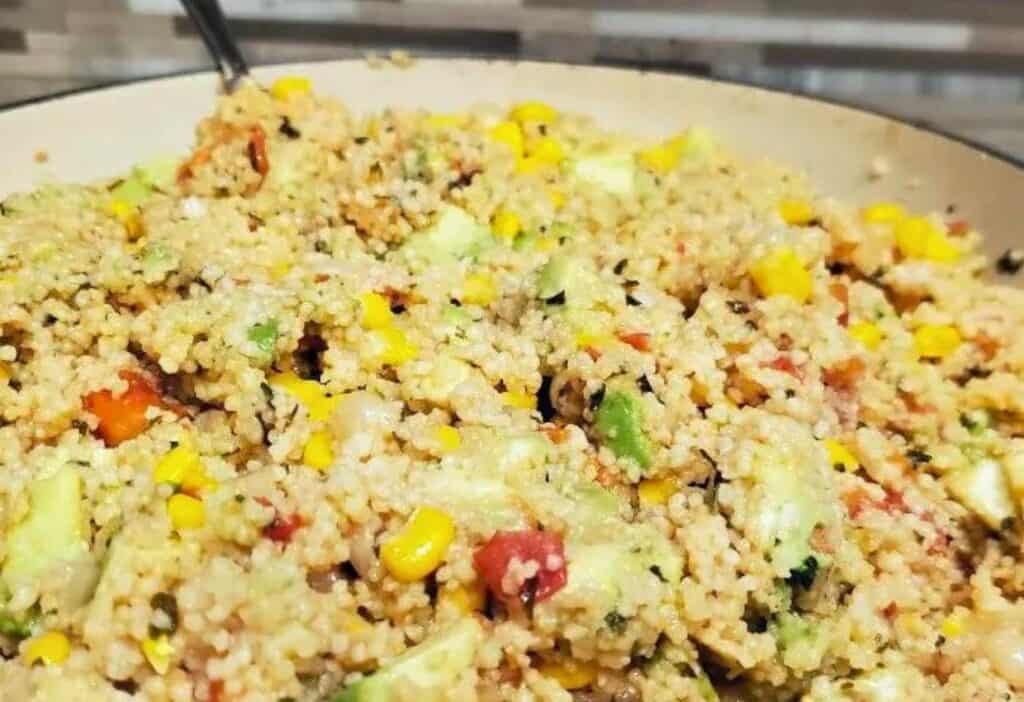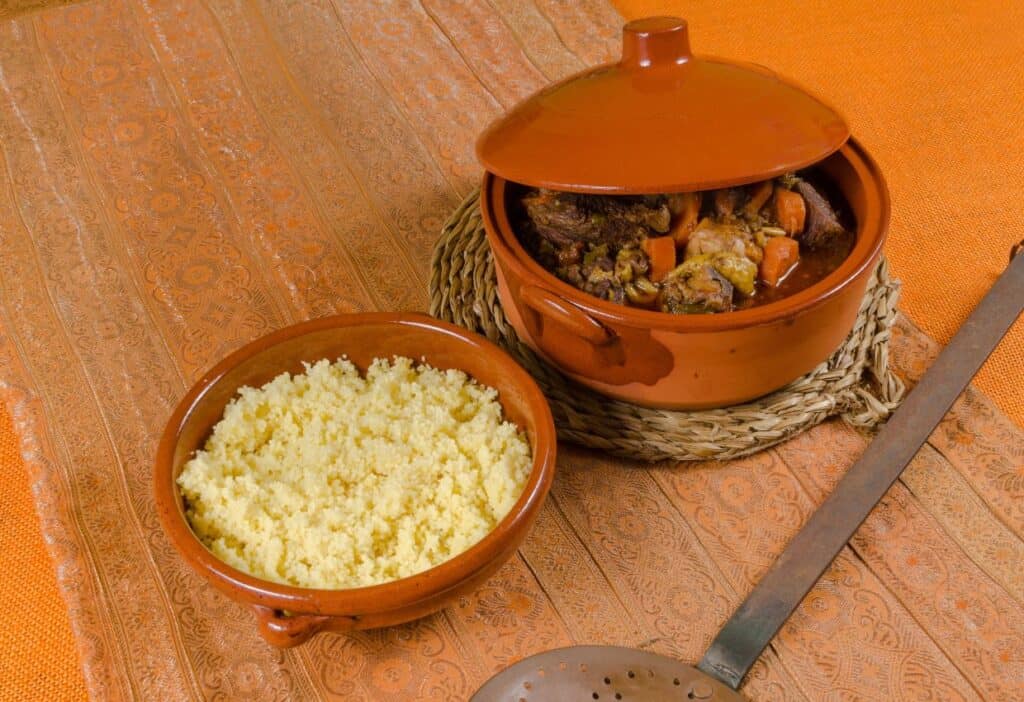In the realm of versatile grains, couscous stands out as a culinary chameleon. This tiny pasta is not just a substitute for another grain. It is a fantastic side dish that can range from sweet to savory when you know how to cook couscous right.

What is couscous?
Couscous has its roots in North Africa and the Middle East, and many dishes that use it incorporate these flavors and traditions, but not all do. It has become more common across the world in recent decades, and you can find it in your standard grocery store today.
Couscous is a type of pasta made from crushed and steamed wheat. It is not often used like traditional pasta, however. Its unique production process creates spherical granules that are the hallmark of couscous, and this is what gives couscous its unique mouthfeel and usage
It starts as coarsely ground durum wheat, which gets moistened and rolled into tiny beads. These beads are then steamed, allowing them to maintain their individual integrity and impart a light, fluffy texture.
Why should you make couscous?
Couscous is a time-strapped cook’s dream. With its quick cooking time and adaptability, it effortlessly accommodates various ingredients and flavors, making it a go-to for busy households.
Couscous can run the gamut from sweet to savory dishes, whether you want to make a vegetable-filled couscous salad, a carrot and raisin-studded sweet or add the pearls to your salad. Beyond its convenience, couscous boasts a delightful texture — tiny pearls that dance between your teeth, providing a unique mouthfeel that adds to the overall enjoyment of the dish.

What are the different kinds of couscous?
Navigating the couscous aisle can be bewildering with the array of options, and there are slight differences in how to cook couscous based on their size. There are three main types of couscous: Moroccan, Israeli and Lebanese. You can also find tri-color couscous.
Moroccan couscous is the smallest, often used in salads. Its small size allows it to absorb flavors as it cooks. Typically, you want to use this in lighter, more refreshing dishes.
FDL’S 75 Best Bites

Our cookbook with 75 tasty recipes will be your go-to kitchen companion for easy dinners with ad-free recipes right at your fingertips. Crafted by experienced chefs and recipe developers, this collection offers a treasure trove of tried-and-true dishes that make mealtime a breeze.
Get the Recipe: FDL’S 75 Best Bites
Israeli couscous, also known as pearl couscous, is larger and offers a chewier bite. Its robust structure makes it an excellent choice for heartier dishes, such as stews and casseroles. It pairs well with rich sauces and grilled meats.
Lebanese couscous, or Moghrabieh, is the largest, resembling small pearls and lending a heartier texture to dishes. Moghrabieh’s larger size allows it to stand up well to robust flavors, making it an excellent choice for dishes with strong, savory components. Use it in soups, stews or mixed with roasted vegetables.
Tri-color couscous adds an aesthetically pleasing element to the couscous family. Combining traditional couscous with vibrant hues derived from natural ingredients like spinach and tomato, tri-color couscous elevates the visual appeal of dishes. Beyond its striking appearance, it maintains the versatility of standard couscous.
Is couscous gluten-free?
Traditional couscous is not gluten-free as it is made from durum wheat. However, there are gluten-free alternatives made from corn or rice, providing a suitable option for those with gluten sensitivities or celiac disease.
People often confuse couscous with quinoa and amaranth which are pasta-like grains that are not made from wheat and are naturally gluten-free. Couscous is technically a pasta and not a grain.
What liquids work best to cook couscous?
The secret to perfect couscous lies in the cooking liquid, but you have options that don’t impact how to cook couscous just the flavor. While water is the most common choice, using broth adds depth and additional taste.
Experiment with vegetable or chicken broth to infuse your couscous with an extra layer of richness. For a hint of Mediterranean flair, consider using a mix of water and olive oil. This creates a luscious base that elevates the overall taste.
How do you cook couscous?
Learning how to cook couscous is a straightforward process. Choose a pot that provides ample space for the couscous to expand.
A medium-sized saucepan with a tight-fitting lid is often ideal. The goal is to allow the couscous to absorb the cooking liquid evenly and achieve that coveted fluffy texture.
The water-to-couscous ratio is a crucial element in the cooking process. For every cup of couscous, use approximately 1½ cups of your chosen liquid. Bring the liquid to a boil before adding the couscous, ensuring a quick and efficient cooking process.
For traditional Moroccan couscous, a brief simmer of about 5 minutes is typically sufficient. However, for larger varieties like Israeli, also known as pearl, couscous or Lebanese, correctly called Moghrabieh, couscous, a slightly longer cooking time of 10 to 12 minutes may be necessary. It’s essential to follow the package instructions and taste-testing to achieve the desired tenderness.
Determining when couscous is done involves a visual and textural assessment. Once the liquid has been absorbed, use a fork to fluff the couscous. The grains should be separate and tender, with no residual crunch.
Take care not to overcook, as couscous can turn mushy if left on the heat for too long. The end result should be a light and airy couscous ready to be paired with your favorite dishes or enjoyed as a standalone delight.
What do you serve with couscous?
Once you have figured out how to cook couscous, you now see that it is a fantastic companion to a variety of dishes. Its neutral flavor pairs well with bold and spicy stews, tangy sauces or grilled meats.
Toss it with roasted vegetables for a satisfying vegetarian option or serve it alongside fish such as a pesto salmon for a light and wholesome meal. The possibilities are as vast as your culinary imagination.
“I make a breakfast couscous, that is similar to cooked oatmeal. Simply cook the small, Moroccan-style couscous in water or apple juice along with some chopped apples, brown sugar and cinnamon. Bring the mixture to a boil, then cover and simmer for 5 minutes and fluff with a fork. Drizzle with a little milk and honey.”
— Jere’ Cassidy, One Hot Oven
Final thoughts
Couscous is not just a time-saving pantry essential; it’s a versatile side dish that allows you to make dishes with diverse flavors and uses. It is a fantastic side dish that many shy away from because it sounds fancy and hard but is well worth using in your dishes once you learn how to cook couscous.
Michelle Price is a food and travel writer at Honest and Truly who almost has an empty nest. She loves to provide both the inspiration and the confidence you need to help get you into the kitchen and on the road to enjoy new flavors and experiences.
